|
|
|
||||||||||||||||||||||||||||||||||||||||||||||||||||||||||||||||||||||||||||||||||||||||||||||||||||||||||||||||||||||||||||||||||||
SOLAR WEATHER
and some interesting space stuff
2010
compiled by Dee Finney
APRIL - 2010
PAGE 4
updated - 4-30-10
THIS COMPILATION IS BEING DONE IN HONOR OF KENT STEADMAN
OF www.cyberspaceorbit.com
who left his earthly abode in 2008
2009 SOLAR WEATHER
JANUARY -
FEBRUARY -
MARCH -
APRIL -
MAY -
JUNE -
JULY -
AUGUST -
SEPTEMBER -
OCTOBER -
NOVEMBER
-
DECEMBER
2010 SOLAR WEATHER
JANUARY -
FEBRUARY -
MARCH -
APRIL -
MAY - JUNE - JULY
AUGUST - SEPTEMBER - OCTOBER - NOVEMBER - DECEMBER
On January 17, there were 1092 potentially hazardous
asteroids.
On February 17, there were 1100 potentially hazardous asteroids.
NOTE: These are not 'new' asteroids' merely newly discovered by
people and their new telescopes.
On March 24, there were 1110 potentially hazardous asteroids.
On April 5, there are 1110 potentially hazardous asteroids.
On April 14, there are 1117 potentially hazardous asteroids.
|
|||||||||||||||||||||||||||||||||||||||||||||||||||||||||||||||||||||||||||||||||||||||||||||||||||||||||||||||||||||||||||||||||||||||
|
TOWARD THE END OF TIME
NEW
A STAR NAMED HADES
NEW
PHOBOS?
HOW DID ALL THOSE
LINES GET THERE?
|
| 4-30-10 SUNSPOTS AHOY! Amateur astronomer Thomas Ashcraft of New Mexico reports a bipolar sunspot group forming in the sun's northeastern quadrant. He took these photos on April 30th around 1730 UT. Readers with solar telescopes are encouraged to monitor developments. Current conditions
speed: 393.0 km/sec density: 0.2 protons/cm3 explanation | more data Updated: Today at 2344 UT
6-hr max: C1 1935 UT Apr30 24-hr: C1 1935 UT Apr30 explanation | more data Updated: Today at: 2340 UT
Giant Blizzard Raging on Saturn Is Visible From Earth
Updated: 17 hours 38 minutes ago
SPACE.com Staff Space.com
(April 30) - A massive blizzard is raging on Saturn - a storm
so large and fierce NASA astronomers and amateur skywatchers can
see it from Earth.
NASA's Cassini spacecraft currently orbiting Saturn has a front row seat to the otherworldly tempest and is recording the most detailed data yet of storms on the ringed planet. But amateur astronomers back on Earth have also managed to chip in on the Saturn blizzard stormwatch. "We were so excited to get a heads-up from the amateurs," said Cassini scientist Gordon Bjoraker, a composite infrared spectrometer team member based at NASA's Goddard Space Flight Center in Greenbelt, Md. 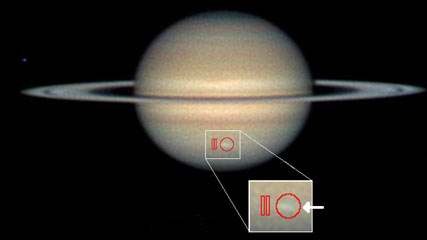
Christopher Go, GSFC / JPL- Caltech / NASA
Amateur astronomer Christopher Go, who lives in the
Philippines, took this image of the storm on Saturn at
its peak on March 13. The arrow indicates the location
of the storm.
The data showed a large, turbulent storm, dredging up a lot of material from the deep atmosphere and covering an area at least five times larger than the biggest blizzard that hit Earth so far this year - the "Snowmageddon" storm that blanketed the Washington, D.C. area in snow in February. Saturn's 'storm alley' Cassini's radio and plasma wave instrument and imaging cameras have been tracking thunder and lightning storms on Saturn for years in a region around Saturn's mid-latitudes that is nicknamed "storm alley." But, gathering data on storms requires a tricky balancing act, since storms on Saturn can come and go on a time scale of weeks, while Cassini's imaging and spectrometer observations have to be locked in place months in advance. Given these limitations, NASA sometimes enlists the help of amateur astronomers. The radio and plasma wave instrument regularly picks up electrostatic discharges that are associated with the storms, so scientists have been sending periodic tips to amateurs, who can quickly go to their backyard telescopes and try to spy the bright convective storm clouds. Amateur astronomers Anthony Wesley, Trevor Barry and Christopher Go received one of those notices in February, and were able to snap dozens of pictures over the next several weeks. In fact, in late March, Wesley - who is based in Australia and was the first person spot the aftermath of an comet impact on Jupiter last summer - sent Cassini scientists an e-mail with a picture of the storm attached. "I wanted to be sure that images like these were being seen by the Cassini team just in case this was something of interest to be imaged directly by Cassini or the Hubble Space Telescope," Wesley wrote. Cassini scientists analyzed all the images in detail, including a picture from March 13 of the storm at its peak, taken by Go, who lives in the Philippines. Saturn's storm season Luckily, the composite infrared spectrometer happened to be targeting the latitude of the storms. The Cassini scientists had known there might be storms in that area, but were unsure when they might be active. The Cassini spectrometer obtained data on March 25 and 26 that showed larger than expected amounts of phosphine, a gas typically found in Saturn's deep atmosphere, and an indicator that powerful currents were lifting material upward into the upper troposphere. The spectrometer data also showed that the tropopause, which is the dividing line between the serene stratosphere and the lower churning troposphere, was about 1 degree Fahrenheit (minus 17.2 degrees Celsius) colder in the storm cell than in neighboring areas. "A balloonist floating about 100 kilometers (62 miles) down from the bottom of Saturn's calm stratosphere would experience an ammonia-ice blizzard with the intensity of Snowmageddon," said Brigette Hesman, a composite infrared spectrometer team member and assistant research scientist at the University of Maryland. "These blizzards appear to be powered by violent storms deeper down - perhaps another 100 to 200 kilometers (62 to 124 miles) down - where lightning has been observed and the clouds are made of water and ammonia," Hesman said. The Cassini-Huygens mission is a joint project of NASA, the European Space Agency and the Italian Space Agency. The composite infrared spectrometer team is based at NASA's Goddard Space Flight Center in Greenbelt, Md. * The Wildest Weather in the Galaxy * The Rings and Moons of Saturn * Top 10 Extreme Planet Facts
Filed under:
Science
|
||||||||
4-29-10 - sunspot
1063- very small WHAT IS COMING THIS WAY PAST THE SUN???? the devil in a speedboat??? Current conditions
speed: 366.4 km/sec density: 3.9 protons/cm3 explanation | more data Updated: Today at 0305 UT
6-hr max: A7 2240 UT Apr29 24-hr: A7 1735 UT Apr29 explanation | more data Updated: Today at: 2355 UT |
||||||||
| 4-28-10 - no su nnspots PLASMA RAIN: NASA's Solar Dynamics Observatory (SDO) has just observed a massive eruption on the sun. Movies ten times better than HDTV show billions of tons of material blasting into space while debris from the explosion rains around the blast site. Moon-sized fragments of plasma splash brightly when they land back on the sun's surface:
Veteran solar physicists say they've never seen anything quite like it. The fluid detail of SDO's imagery is unprecedented, prompting NASA to dub it their "Hubble for the Sun." SDO has already solved one mystery of plasma rain: The rain falls with puzzling slowness, seemingly resisting the sun's powerful gravity. What slows the descent? The phenomenon is explained in today's story from Science@NASA. Current conditions
speed: 317.5 km/sec density: 1.5 protons/cm3 explanation | more data Updated: Today at 1255 UT
6-hr max: A4 0950 UT Apr28 24-hr: A4 0515 UT Apr28 explanation | more data Updated: Today at: 1245 UT |
||||||||
| 4-27-10 No sunspots CORONAL HOLE: A dark hole has formed in the sun's atmosphere. NASA's STEREO-B spacecraft photographed it just hours ago:
It's a "coronal hole," a vast region where solar magnetic fields have opened up and allowed some of the sun's atmosphere to escape. The runaway atmosphere is heading our way in the form of a solar wind stream. High-latitude sky watchers should be alert for auroras when it arrives on or about May 3rd. Current conditions speed: 364.1 km/sec density: 1.8 protons/cm3 explanation | more data Updated: Today at 2345 UT 6-hr max: A4 1825 UT Apr27 24-hr: A5 1400 UT Apr27 explanation | more data Updated: Today at: 2340 UT |
||||||||
| 4-26-10 - No sunspots POISED TO ERUPT: Already this month, the sun has produced two of the biggest eruptions in years. They occurred on April 13th and April 19th when magnetic filaments became unstable and exploded. Could it happen again today? A prominence on the eastern limb of the sun (photo) resembles the precursors of those two earlier blasts. Readers with solar telescopes are encouraged to monitor developments.
Current conditions
speed: 349.7 km/sec density: 9.0 protons/cm3 explanation | more data Updated: Today at 1426 UT
6-hr max: A8 0930 UT Apr26 24-hr: A8 0930 UT Apr26 explanation | more data Updated: Today at: 1420 UT
|
||||||||
4-25-10 - No sunspots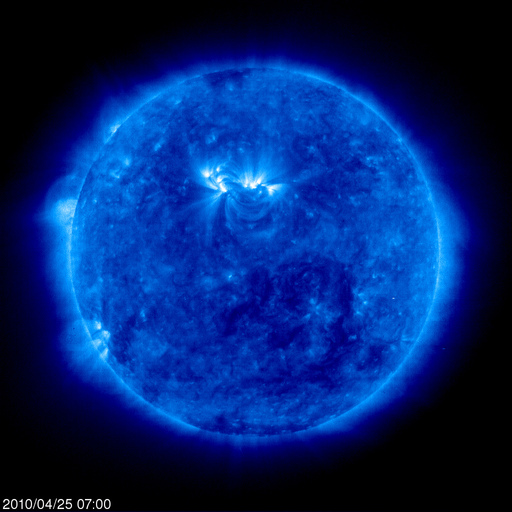 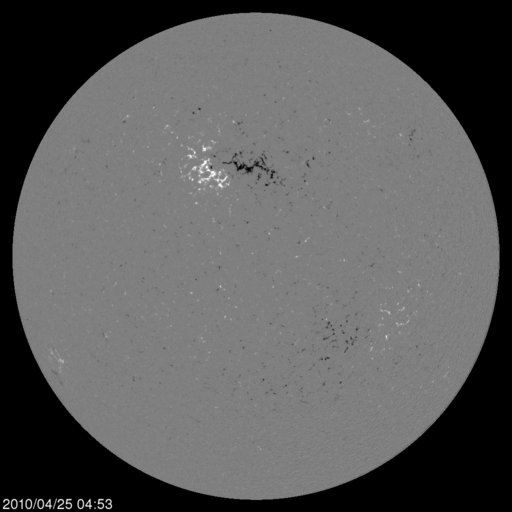 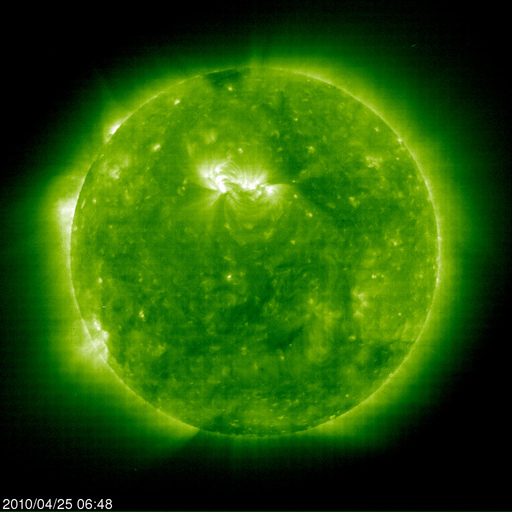
Current conditions
speed: 395.5 km/sec density: 1.0 protons/cm3 explanation | more data Updated: Today at 0130 UT
6-hr max: B1 2300 UT Apr24 24-hr: B1 2300 UT Apr24 explanation | more data Updated: Today at: 2355 UT
|
||||||||
| 4-24-10 - No sunspots Current conditions
speed: 327.6 km/sec density: 0.1 protons/cm3 explanation | more data Updated: Today at 2342 UT
6-hr max: B1 2300 UT Apr24 24-hr: B1 2300 UT Apr24 explanation | more data Updated: Today at: 2340 UT
|
||||||||
4-23-10 - No sunspots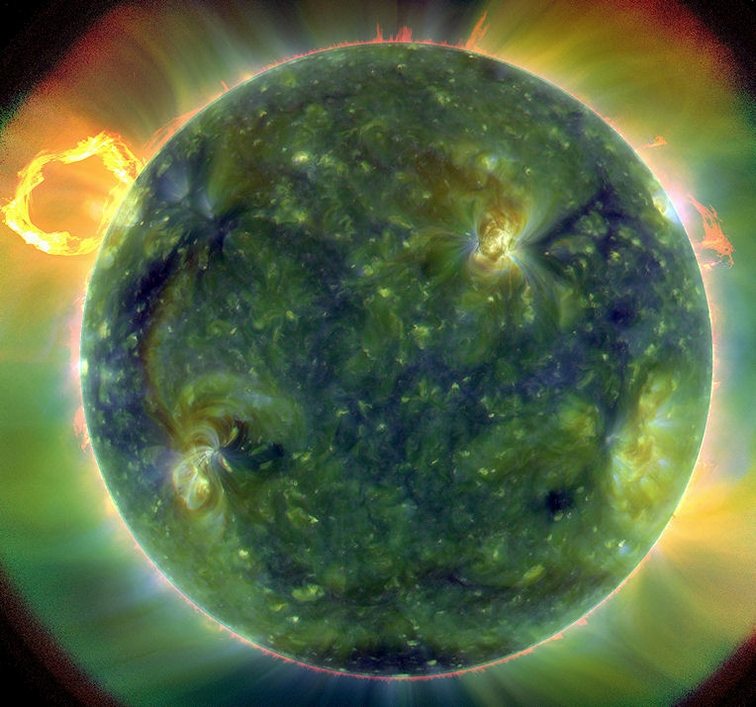
A full-disk multiwavelength extreme ultraviolet image of the sun
taken by SDO on March 30, 2010. False colors trace different gas
temperatures. Reds are relatively cool (~60,000 K); blues and greens
are hotter (> 1,000,000 K). [full-resolution
image]
Credit: SDO/AIA
Current conditions
speed: 445.4 km/sec density: 1.5 protons/cm3 explanation | more data Updated: Today at 2346 UT
6-hr max: A4 2325 UT Apr23 24-hr: A4 2325 UT Apr23 explanation | more data Updated: Today at: 2340 UT |
||||||||
| 4-22-10 - No sunspots Current conditions
speed: 420.6 km/sec density: 1.3 protons/cm3 explanation | more data Updated: Today at 2345 UT
6-hr max: A4 1905 UT Apr22 24-hr: A4 1730 UT Apr22 explanation | more data Updated: Today at: 2340 UT |
||||||||
| 4-21-10 - No sunspots STUNNING IMAGES OF THE SUN: NASA's Solar Dynamics Observatory is beaming back stunning new images of the sun, revealing our own star as never seen before. Even veteran solar physicists say they are amazed by the data. Click on the prominence, below, to see what everyone is so excited about: Related links:
Current conditions
speed: 438.8 km/sec density: 0.6 protons/cm3 explanation | more data Updated: Today at 2345 UT
6-hr max: A3 2310 UT Apr21 24-hr: A3 1135 UT Apr21 explanation | more data Updated: Today at: 2340 UT
|
||||||||
4-20-10 - No sunspots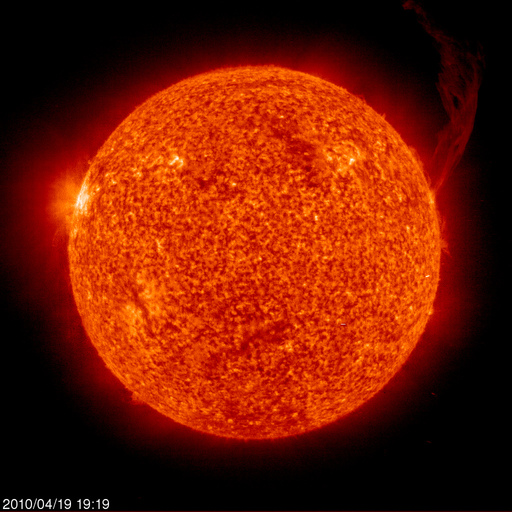 A solar prominence erupts on April 19th at 1919 UT The eruption catapulted a billion-ton CME out of the sun's atmosphere. SOHO saw that, too: movie. The expanding cloud is not heading for Earth, so we should feel no effects. The event was photogenic but not geoeffective Current conditions
speed: 363.5 km/sec density: 1.2 protons/cm3 explanation | more data Updated: Today at 2345 UT
6-hr max: A3 1950 UT Apr20 24-hr: A4 1215 UT Apr20 explanation | more data Updated: Today at: 2340 UT |
||||||||
| 4-19-10 - No sunspots Current conditions
speed: 346.8 km/sec density: 0.5 protons/cm3 explanation | more data Updated: Today at 2344 UT
6-hr max: A4 2140 UT Apr19 24-hr: A4 0005 UT Apr19 explanation | more data Updated: Today at: 2340 UT
|
||||||||
| 4-18-10 - No sunspots Current conditions
speed: 380.1 km/sec density: 0.3 protons/cm3 explanation | more data Updated: Today at 2346 UT
6-hr max: A5 1935 UT Apr18 24-hr: B1 0205 UT Apr18 explanation | more data Updated: Today at: 2340 UT |
||||||||
| 4-17-10 - No sunspots Current conditions
speed: 385.0 km/sec density: 0.2 protons/cm3 explanation | more data Updated: Today at 2345 UT
6-hr max: A6 2330 UT Apr17 24-hr: B2 0555 UT Apr17 explanation | more data Updated: Today at: 2340 UT |
||||||||
| 4-16-10 - no sunspots Current conditions
speed: 463.6 km/sec density: 2.2 protons/cm3 explanation | more data Updated: Today at 1227 UT
6-hr max: A4 0950 UT Apr16 24-hr: A4 0950 UT Apr16 explanation | more data Updated: Today at: 1220 UT
|
||||||||
| 4-15-10- no sunspots Current conditions
speed: 485.4 km/sec density: 3.2 protons/cm3 explanation | more data Updated: Today at 0053 UT
6-hr max: A3 2025 UT Apr14 24-hr: A3 2025 UT Apr14 explanation | more data Updated: Today at: 2355 UT MIDWESTERN FIREBALL: A brilliant fireball streaked across the USA on the evening of April 14th, startling observers in Minnesota, Iowa, Missouri and surrounding states. Experts say it was a small asteroid, about a meter wide, that exploded in mid-air with an energy equivalent to some 20 tons of TNT. National Weather Service radars detected the fireball's debris trail, resulting in maps that could help guide meteorite hunters to fragments on the ground. My own son, who was driving to work saw the ball of green light for about 5 seconds before it went behind some buildings and trees and out of sight in Milwaukee, WI. Last night, around 10:05 pm CDT, sky watchers in Minnesota, Wisconsin, Iowa, Illinois and Missouri witnessed a brilliant green fireball streaking across the sky. Images from a rooftop webcam in Madison, Wisconsin, show a brilliant midair explosion:
The fireball was caused by a small asteroid hitting Earth's atmosphere at a shallow angle. Preliminary infrasound measurements place the energy of the blast at 20 tons of TNT (0.02 kton), with considerable uncertainty. Bill Cooke of NASA's Meteoroid Environment Office estimates that the space rock was about 1 meter wide and massed some 1260 kg. "Fireballs of this size are surprisingly common," he notes. "They hit Earth about 14 times a month, on average, although most go unnoticed because they appear during the day or over unpopulated areas."
photo taken over Milwaukee, Wi - facing northeast Many readers have asked if fragments of the meteoroid might have reached Earth. The answer is "yes." Cooke advises looking directly underneath the fireball's debris trail, which was pinged by National Weather Service radars in Iowa. Click here and here for maps. News video: from WISN in Milwaukee, Wisconsin; from a sheriff's dashcam in Elma, Iowa; Not a gamma Virginid: Contrary to some reports, this fireball was not a member of the gamma Virginid meteor shower, a minor shower that peaks in mid-April. The fireball's timing and trajectory do not match what would be expected for a gamma Virginid. Other people suggested it was part of a failed space shot by Russia the day before, or part of debris from a space war going on overhead. There were planety of conspiracy theories going on as well. VOLCANIC SUNSETS: A cloud of ash from Iceland's Eyjafjallajokull volcano is drifting across Europe this week and causing sunsets of surpassing beauty. Europeans are encouraged to look west at the end of the day. Bonus: If you don't live in Europe, look west anyway. Venus, Mercury and the crescent Moon are beaming through the twilight for all to see. Images: #1, #2, #3, #4, #5, #6, #7, #8, #9, #10. |
||||||||
| 4-14-10 - sunspot 1062 Current conditions
speed: 474.2 km/sec density: 3.6 protons/cm3 explanation | more data Updated: Today at 2344 UT
6-hr max: A3 2025 UT Apr14 24-hr: A3 2025 UT Apr14 explanation | more data Updated: Today at: 2340 UT
|
||||||||
| 4-13-10 - sunspot 1062 OMG! HUGE PROMINENCE: One of the biggest prominences in years erupted from the sun's northwestern limb today. The massive plasma-filled structure rose up and burst during a ~2 hour period around 0900 UT. Mark Townley sends this freeze-frame from his backyard observatory in Brierley Hill, West Midlands, UK:
The eruption hurled a bright coronal mass ejection (CME) into space: SOHO movie. The cloud is not heading toward Earth, at least not directly. A glancing blow from the outskirts of the CME is possible two to three days from now, but any impact is likely to be mild. The eruption was more photogenic than geoeffective. more images: from Steve Wainwright of Gower, South Wales UK; from Patrick Bornet of Saint Martin sur Nohain, Nièvre, France; from Robert Arnold of Isle of Skye, Scotland; from Les Observateurs Associés au Pic du Midi, France; from Gianfranco Meregalli of Milano Italy Current conditions
speed: 375.5 km/sec density: 1.8 protons/cm3 explanation | more data Updated: Today at 1856 UT
6-hr max: A3 1640 UT Apr13 24-hr: B2 0445 UT Apr13 explanation | more data Updated: Today at: 1855 UT |
||||||||
| 4-12-10 - A new sunspot is appearing in the southern hemishphere
it can't be seen yet NEW SUNSPOT: A new sunspot (provisionally numbered AR1062) is rapidly emerging in the sun's southern hemisphere. Readers with solar telescopes, now is the time to watch sunspot genesis in action. Images: from Thomas Ashcraft of New Mexico; GEOMAGNETIC STORM: A coronal mass ejection hit Earth's magnetic field at approximately 12:30 UT on April 11th. The impact sparked a G2-class geomagnetic storm with auroras over Scandinavia, Scotland, Canada and northern-tier US states such as Maine, Michigan and Wisconsin. Current conditions
speed: 434.6 km/sec density: 2.3 protons/cm3 explanation | more data Updated: Today at 1854 UT
6-hr max: A3 1505 UT Apr12 24-hr: A6 0105 UT Apr12 explanation | more data Updated: Today at: 1855 UT |
||||||||
| 4-11-10 - sunspot 1061 Current conditions
speed: 419.0 km/sec density: 9.7 protons/cm3 explanation | more data Updated: Today at 2345 UT
6-hr max: A6 2305 UT Apr11 24-hr: A6 2305 UT Apr11 explanation | more data Updated: Today at: 2340 UT |
||||||||
| 4-10-10 - sunspot 1061 INCOMING CME: Decaying sunspot 1060 delivered a parting shot on April 8th. The active region's magnetic field erupted, sparking a B3-class solar flare and hurling a faint coronal mass ejection (CME) almost directly toward Earth. Geomagnetic disturbances are possible when the cloud arrives on April 11th or 12th. April 4th marked the beginning of a major solar wind storm, which is only now subsiding. The four-day event brought auroras to the lava fields of Iceland, created a kaleidoscopic display of moving color over Antarctica, and lured onlookers in Siberia outdoors for a quick "aurora dance." Really. Browse the gallery for photos. UPDATED:
April Northern Lights Gallery The comet was probably a member of the Kreutz sungrazer family. Named after a 19th century German astronomer who studied them in detail, Kreutz sungrazers are fragments from the breakup of a giant comet at least 2000 years ago. Several of these fragments pass by the sun and disintegrate every day. Most are too small to see but occasionally a big fragment like today's attracts attention. This has been an active year for big, bright sungrazers. There was one on Jan. 4th, one on March 12th, and now one today. Normally we see no more than 3 or 4 bright ones in a whole year; now we're seeing them almost once a month. It could be a statistical fluctuation or, maybe, a swarm of Kreutz fragments is nearing perihelion (closest approach to the sun). SOLAR WIND STORM: The first major solar wind storm of the new solar cycle has come to an end. The event, which stretched from April 4th to April 8th, ignited auroras over both poles and many points in between. Highlights include Northern Lights over an active volcano in Iceland, green skies in Minnesota, and a kaleidoscopic display of Southern Lights over Antarctica. Start browsing the updated aurora gallery here: 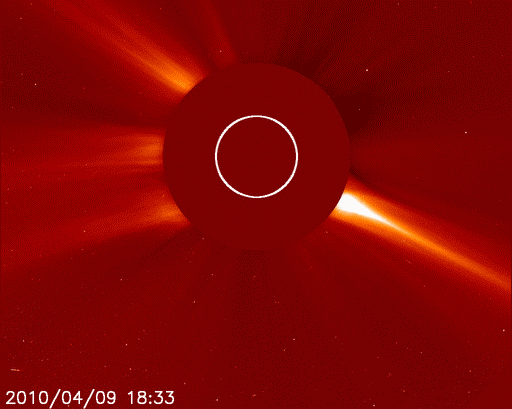 http://www.spaceweather.com/aurora/gallery_01apr10_page5.htm Current conditions speed: 455.4 km/sec density: 0.4 protons/cm3 explanation | more data Updated: Today at 0115 UT
6-hr max: A9 2035 UT Apr09 24-hr: B3 0450 UT Apr09 explanation | more data Updated: Today at: 2355 UT
|
||||||||
| 4-9-10 - sunspot 1061 Current conditions
speed: 460.3 km/sec density: 0.7 protons/cm3 explanation | more data Updated: Today at 2344 UT
6-hr max: A9 2035 UT Apr09 24-hr: B3 0450 UT Apr09 explanation | more data Updated: Today at: 2340 UT |
||||||||
| 4-8-10 -sunspots 1060 and 1061 Current conditions speed: 604.1 km/sec density: 0.2 protons/cm3 explanation | more data Updated: Today at 0234 UT
6-hr max: A6 2355 UT Apr07 24-hr: A6 2355 UT Apr07 explanation | more data Updated: Today at: 2355 UT GEOSTORMS, CONTINUED: High-latitude sky watchers should remain alert for auroras. NOAA forecasters estimate a 45% chance of geomagnetic activity and a 10% chance of severe geomagnetic storms during the next 24 hours. The source of this activity is a fast and gusty solar wind stream that has been blowing around Earth for two days. [UPDATED: gallery].
|
||||||||
| 4-7-10 - sunspots 1060 and 1061 Current conditions
speed: 601.7 km/sec Keep your eye on the speed of the solar wind density: 0.4 protons/cm3 explanation | more data Updated: Today at 0322 UT
6-hr max: A5 1805 UT Apr06 24-hr: B1 0400 UT Apr06 explanation | more data Updated: Today at: 2355 UT |
||||||||
| 4-6-10 sunspot 1060 and 1061 The most powerful geomagnetic storm since December 2006 struck the Earth on Monday. The most powerful geomagnetic storm since December 2006 struck the Earth on Monday. The solar storm prompted NOAA to issue a Space Weather Advisory on Monday ordering all personnel on the space shuttle and International Space Station to take cover in specially designed compartment shields. Charged particles come in the form of galactic cosmic rays, gamma rays, solar flares, and CME's. The Kp Index measures from 1 (mild) to 9 (severe). Monday's hit measured 7.
On 3 April, the SOHO spacecraft spotted a cloud of charged particles called a coronal mass ejection (CME) shooting from the Sun at 500 kilometers per second. This velocity suggested the front would reach Earth in roughly three days. Equation: Charged Particles => Magnetic Field Shift => Shifting Ocean and Jet Stream Currents => Extreme Weather and Human Disruption (mitch battros).
A sharp gust of solar wind hit Earth's magnetosphere on Monday, April 5th, at approximately 0800 UT and sparked the strongest geomagnetic storm of the year. "It hit earlier and harder than forecast," says Doug Biesecker of the US National Oceanic and Atmospheric Administration's (NOAA) Space Weather Prediction Center in Boulder, Colorado. Current conditions
speed: 554.4 km/sec density: 0.6 protons/cm3 explanation | more data Updated: Today at 2344 UT
6-hr max: A5 1805 UT Apr06 24-hr: B1 0400 UT Apr06 explanation | more data Updated: Today at: 2340 UT
|
||||||||
| 4-5-10 -sunspot 1060 just came around the corner - 1057 and
1059 disappeared overnight GEOMAGNETIC STORM: A sharp gust of solar wind hit Earth's magnetosphere today, April 5th, at approximately 0800 UT and sparked the strongest geomagnetic storm of the year. The event registered 7 on the 0-to-9 Kindex scale of magnetic disturbances. Although the storm is subsiding now, it is not over; high-latitude sky watchers should remain alert for auroras. Latest images may be found in the gallery: http://www.spaceweather.com/aurora/gallery_01apr10_page3.htm Current conditions speed: 647.3 km/sec density: 0.7 protons/cm3 explanation | more data Updated: Today at 2243 UT 6-hr max: B1 1700 UT Apr05 24-hr: B1 1250 UT Apr05 explanation | more data Updated: Today at: 2240 UT |
||||||||
| 4-4-10 - sunspots 1057 and 1059 Current conditions speed: 489.5 km/sec density: 0.5 protons/cm3 explanation | more data Updated: Today at 2342 UT 6-hr max: A9 2005 UT Apr04 24-hr: B1 0900 UT Apr04 explanation | more data Updated: Today at: 2340 UT |
||||||||
| 4-3-10 - sunspots 1057 and 1059 Current conditions speed: 515.2 km/sec density: 0.4 protons/cm3 explanation | more data Updated: Today at 2343 UT 6-hr max: A9 1810 UT Apr03 24-hr: B7 0950 UT Apr03 explanation | more data Updated: Today at: 2340 UT |
||||||||
| 4-2-10 - sunspots 1057 and 1059 Current conditions speed: 511.9 km/sec density: 1.1 protons/cm3 explanation | more data Updated: Today at 2345 UT 6-hr max: A7 2315 UT Apr02 24-hr: A7 2315 UT Apr02 explanation | more data Updated: Today at: 2340 UT |
||||||||
| 4-1-10 - sunspots - 1057 and 1059 SOLAR PROMINENCE: Today, amateur astronomers around the world are monitoring a huge prominence rising over the sun's northeastern limb. It's so big, it won't fit in the space provided.
Eric Roel took the picture just hours ago from his backyard observatory in Valle de Bravo, Mexico. Since then, the view has changed. Magnetic fields underpinning this magnificent structure are in a state of fairly rapid motion, pulling the plasma to and fro, offering a different profile to every observer. The whole thing could become unstable and collapse. Readers with solar telescopes are encouraged to monitor developments. more images: from Andy Devey of Barnsley, South Yorkshire, England; from Cai-Uso Wohler of Bispingen, Germany; Current conditions speed: 466.3 km/sec density: 1.5 protons/cm3 explanation | more data Updated: Today at 2344 UT 6-hr max: A4 1830 UT Apr01 24-hr: A6 0900 UT Apr01 explanation | more data Updated: Today at: 2340 UT |
SPACE DATABASE ON THIS SITE
DREAMS OF THE GREAT EARTHCHANGES -
MAIN INDEX